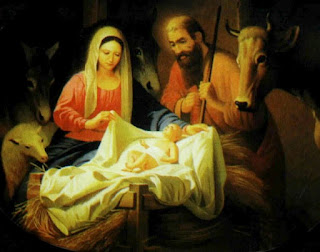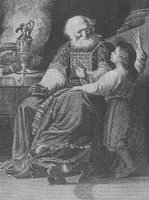 Samuel was the final Old Testament judge. Besides Deborah and an anonymous man in Judges 6:7-10, he is the first prophet mentioned after Moses, although we could consider some of the other judges among the prophets. He lived during the 11th century B.C. Samuel's mother Hannah was unable to have children and she prayed desperately before the tabernacle that the Lord would grant her to bear children to her husband Elkanah, an Ephraimite. Because the Lord heard and answered, Hannah called her son "Samuel," which can be translated "heard by God." This account is in the first chapter of 1 Samuel.
Samuel was the final Old Testament judge. Besides Deborah and an anonymous man in Judges 6:7-10, he is the first prophet mentioned after Moses, although we could consider some of the other judges among the prophets. He lived during the 11th century B.C. Samuel's mother Hannah was unable to have children and she prayed desperately before the tabernacle that the Lord would grant her to bear children to her husband Elkanah, an Ephraimite. Because the Lord heard and answered, Hannah called her son "Samuel," which can be translated "heard by God." This account is in the first chapter of 1 Samuel.In response to God's love for them, Samuel's parents dedicated him to the Lord's service: "And when she had weaned him, she took him up with her, along with a three-year-old bull, an ephah of flour, and a skin of wine, and she brought him to the house of the Lord at Shiloh. And the child was young. Then they slaughtered the bull, and they brought the child to Eli [the priest in the Lord's house]. And she said, 'Oh, my lord! As you live, my lord, I am the woman who was standing here in your presence, praying to the Lord. For this child I prayed, and the Lord has granted me my petition that I made to him. Therefore I have lent him to the Lord. As long as he lives, he is lent to the Lord.' (1:24-28)" He entered sacred service and trained in the house of the Lord at Shiloh under Eli.
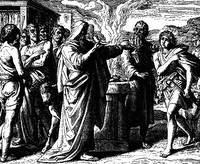 God called Samuel to speak for Him in a series of night messages and established him as His prophet. One of Samuel's most difficult assignments came immediately after his call. Eli was allowing his sons to abuse their priestly offices and through the young man, the Lord condemned their behavior and pronounced God's judgment upon them (see chapter 3).
God called Samuel to speak for Him in a series of night messages and established him as His prophet. One of Samuel's most difficult assignments came immediately after his call. Eli was allowing his sons to abuse their priestly offices and through the young man, the Lord condemned their behavior and pronounced God's judgment upon them (see chapter 3).Samuel's own life didn't always go smoothly. Just as Eli's sons had betrayed their sacred trust as priests, so also "Joel and ... Abijah ..." the sons of Samuel, became unrighteous judges who "took bribes and perverted justice. (8:1-3)" Perceiving this as a problem in God's leadership as well as that of Samuel, Israel demanded that they be given a king such as the surrounding nations had. Samuel warned them that this would lead to even more problems and woes, but when they kept insisting, the Lord told him to do as the people requested.
Samuel anointed Saul to be Israel's first king (10:1). Because of Saul's continuing, flagrant disregard for God's Word, Samuel repudiated Saul's leadership and traveled to the house of Jesse, where he anointed David to be king in place of Saul (16:13).
Samuel's loyalty to God, his spiritual insight, and his ability to inspire others made him one of Israel's great leaders. When he died, "all Israel assembled and mourned for him, and they buried him in his house at Ramah. (25:1a)"
For more on this man of God, see an earlier post that focuses on a series of deceiving appearances in his life.
Labels: biography, commemoration, david, eli, hagiography, hannah, israel, judges, old testament, prophet, samuel, saul
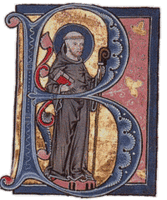 ernard of Clairvaux, a leader in Christian Europe in the first half of the 11th century A.D., is honored in his native France and around the world. Born into a noble Burgundian (Fontaines, near Dijon) family in 1090, he was drawn toward the Church by his own nature and encouraged by his mother's desire. His family opposed His desire to enter a monastery and sent him to study at Châlons in order to qualify him for higher ecclesiastical office. However, Bernard left his affluent heritage, entering the monastery of Citeaux at age 22. He persuaded four of his brothers, an uncle, and 26 other men, mainly the sons of nobles, to join him.
ernard of Clairvaux, a leader in Christian Europe in the first half of the 11th century A.D., is honored in his native France and around the world. Born into a noble Burgundian (Fontaines, near Dijon) family in 1090, he was drawn toward the Church by his own nature and encouraged by his mother's desire. His family opposed His desire to enter a monastery and sent him to study at Châlons in order to qualify him for higher ecclesiastical office. However, Bernard left his affluent heritage, entering the monastery of Citeaux at age 22. He persuaded four of his brothers, an uncle, and 26 other men, mainly the sons of nobles, to join him.After two years he and several others were sent to a new monastic house at Clairvaux, where Bernard soon became its abbot. His work there was blessed in many ways. The monastery at Clairvaux grew in mission and service, eventually establishing some 68 daughter houses.
During the disputed papal elections between Anacletus II and Innocent II, he took the side of Innocent. From 1130-38, Bernard worked to solidify the papal claim through ecclesiastical and secular politics. He battled against the "New Teaching" espoused by Pierre Abélard at the University of Paris, resisting a broad-based liberal arts education using the philosophy of Aristotle. Instead, Bernard insisted that such an education was only to be used in preparation for the priesthood.
At the command of Pope Eugenius III in 1146, Bernard preached in favor of a new effort to free the Holy Land from the Mohammedans. This gave life to the previously moribund Second Crusade. While the results of the campaign were certainly mixed, events during it served to enhance Bernard's perception among non-Christians: When a monk named Radulf (or Raoul) incited the populace of Mainz against the Jews, Bernard vigorously opposed him, calling the monk arrogant, without authority, a preacher of mad and heretical doctrines, a liar, and a murderer. Radulf slipped away, the riots ended, and Bernard became known as a "righteous gentile." His reputation among Rhine valley Jews remained so good that his name is still given to some of their descendants. The most famous of these would probably be American businessman and presidential advisor Bernard Baruch.
Certainly, we remember St. Bernard for his charity and political abilities. Even more, we honor his preaching ability and, especially, his poetry and hymn writing (cf. NetHymnal and Hymnuts at the Internet Archive): The texts of O Jesus, King Most Wonderful (MIDI audio) and O Sacred Head, Now Wounded (MIDI audio), as well as others, remain vital parts of our Christian heritage.
Martin Luther cited Saint Bernard in a number of his writings. When Bernard spoke of justification by grace through faith, Luther commended the teaching. For example, in his commentary on 10, the reformer wrote, "This is the kind of joy and comfort St. Bernard had in his heart, so that he could say, on the basis of this article: 'How can I ever become sad and mournful or discouraged? After all, my flesh and blood sits in heaven above. I expect He will not be my enemy.' For St. Bernard to apply this to himself and to boast this way is certainly a genuinely spiritual, heavenly, and divine thought, derived from his faith. For he had also amounted to something in the world. He had been rich enough, noble, learned, and holy. But before God St. Bernard knows no other boast or comfort than this Lord. (LW 13:245)"
Where Bernard lapsed into exalting the office of the papacy or waxed eloquent on the merits of the saints — particularly Mary — Luther condemned these works as false and misleading. Yet the reformer appreciated and held close the monk's death-bed confession of personal unworthiness and total reliance on Christ's merits: "That is how St. Bernard was saved. He was an exemplary monk; he observed the rules of his order scrupulously, and he fasted so assiduously that his breath stank and no one could abide his presence. But on the threshold of death he exclaimed: 'Oh, I have lived damnably! But heavenly Father, Thou hast given me Thy Son, who has a twofold claim to heaven: first, from eternity, by reason of the fact that He is Thy Son; secondly, He earned heaven as the Son of man with His suffering, death, and resurrection. And thus He has also given and bestowed heaven on me. [Sermones in cantica, Sermon XX, Patrologia, Series Latina, CLXXXIII, 867]' Thereby St. Bernard dropped out of the monastic role, forsook cowl and tonsure and rules, and turned to Christ; for he knew that Christ conquered death, not for Himself but for us men that all who believe in the Son should not perish but have eternal life. And so St. Bernard was saved. (LW 22:360)"
In case you're wondering, the Saint Bernard dog is not named for Bernard of Clairvaux but indirectly for Bernard of Montjoux (or Menthon), an earlier monk who founded a travelers' hospice and monastery in the Pennine Alps and another hospice in the Graian Alps. Both of these passes were later named for him and and the large rescue dogs for these places where they were stationed.
NB: I followed the LCMS Calendar of Commemorations and listed Bernard on 19 August, even though his death date is normally remembered as 20 August and occasionally as the 21st. Roman Catholicism celebrates his feast on the 20th.
Suggested Lection
Psalm 139:1-12 or 19:7-11
Sirach 39:1-10
John 15:7-11
Collect
O God, by whose grace Your servant Bernard of Clairvaux, kindled with the flame of Your love, became a burning and a shining light in your Church, grant that we also may be aflame with the spirit of love and discipline, walking before You as children of light; through Jesus Christ our Lord, who lives and reigns with You and the Holy Spirit, one God, now and for ever.
Be Thou my Consolation, My Shield when I must die;Hymn texts and MIDI audio linked from the Lutheran Hymnal Project.
Remind me of Thy Passion When my last hour draws nigh.
Mine eyes shall then behold Thee, Upon Thy cross shall dwell,
My heart by faith enfold Thee. Who dieth thus dies well!
(P. Gerhardt; from Bernard's Salve caput cruentatum)
Martin Luther quotes from Volume 13: Luther's Works, Selected Psalms II, © 1956 by Concordia Publishing House and Volume 22: Luther's Works, Sermons on the Gospel of St. John: Chapters 1-4, © 1957 by Concordia Publishing House.
Labels: bernard, biography, christianity, church history, clairvaux, commemoration, crusades, hagiography, hymns, medieval history, monasticism
 Born 17 October 1582, Johann Gerhard, a Lutheran theologian in the tradition of Martin Luther (1483-1546) and Martin Chemnitz (1522-86), was the most influential 17th Century dogmatician. Many still consider his Loci Theologici in 23 large volumes to be the most definitive statement of Lutheran orthodoxy. Born in Quedlinburg, Germany, Gerhard was stricken with a life-threatening illness at age 15.
Born 17 October 1582, Johann Gerhard, a Lutheran theologian in the tradition of Martin Luther (1483-1546) and Martin Chemnitz (1522-86), was the most influential 17th Century dogmatician. Many still consider his Loci Theologici in 23 large volumes to be the most definitive statement of Lutheran orthodoxy. Born in Quedlinburg, Germany, Gerhard was stricken with a life-threatening illness at age 15.Following this experience, coupled with with guidance from his pastor, Johann Arndt, Gerhard experienced a turning point: He devoted the rest of his life to theology, serving many years as the Superintendent of Heldberg and, later, of the Duchy of Coburg. Eventually he become a professor at the University of Jena. With a sharp, critically trained mind, Gerhard also possessed deep evangelical piety and love for Jesus.
He wrote exegetical and theological works, devotional literature, history, and polemics. Many of his sermons remain in publication, still exercising wide influence upon confessional Lutheran thought. Since its writing and subsequent translation, his Sacred Meditations probably outsold every book in the Western world except the Bible and The Imitation of Christ by Thomas à Kempis.
His son Johann Ernst Gerhardt was also a Lutheran theologian and professor. An even more noted relative was his nephew, Johannes Andreas Quenstedt.
For more detailed information, see the Studium Excitare, Wikipedia, and the Christian Cyclopedia.
Partial List of Works
† Exegesis: Commentarius in harmoniam historiae evangelicae de passione Christi (A comentary harmonizing the Gospel accounts of Christ's Passion, 1617)
† Exegesis: Comment, super priorem D. Petri epistotam (1641)
† Exegesis: Commentaries on Genesis (1637) and Deuteronomy (1658)
† Theology: Confessio Catholice (Universal Confession, 1633-1637), a defense of the evangelical and catholic nature of the Augsburg Confession
† Theology: Loci communes theologici (1610-1622)
† Devotional: Meditationes sacrae (Sacred Meditations, 1606)
Suggested Lection
Psalm 46
Isaiah 55:6-11
Romans 10:5-17
John 15:1-11
Collect
O Lord God, heavenly Father, pour out Your Holy Spirit upon Your faithful people, keep them steadfast in Your grace and truth, protect and comfort them in all temptation, defend them against all enemies of Your Word, and bestow on Christ's Church Militant Your saving peace; through Jesus Christ, Your Son, our Lord, who lives and reigns with You and the Holy Spirit, one God, now and forever. Amen.
Lord, keep us steadfast in Your Word!
Labels: biography, christianity, church history, commemoration, german history, hagiography, johann gerhard, lutheranism, martin chemnitz, martin luther, theology
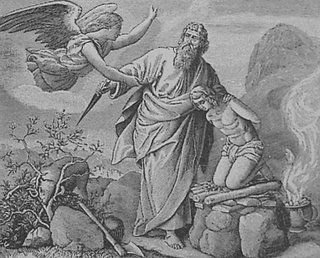 If any part of Scripture besides the Resurrection clearly indicates that God gets the last laugh, it must be the story of Isaac.
If any part of Scripture besides the Resurrection clearly indicates that God gets the last laugh, it must be the story of Isaac.After giving new names to Abraham and Sarah, the Lord promised a them a son. At the time, Abraham was 99 and Sarah was 90 (see Genesis 17). When Abraham heard the news, he "fell on his face and laughed and said to himself, 'Shall a child be born to a man who is a hundred years old? Shall Sarah, who is ninety years old, bear a child?' (v. 17)"
In response to the laughter and doubting, the Lord said, "Sarah your wife shall bear you a son, and you shall call his name Isaac. I will establish my covenant with him as an everlasting covenant for his offspring after him. (v. 19)" Isaac means "He Laughs."
To reiterate His point, the Lord allowed Sarah to overhear Him repeat His promise to Abraham at the Oaks of Mamre (see Genesis 18). "So Sarah laughed to herself, saying, 'After I am worn out, and my lord is old, shall I have pleasure?' The Lord said to Abraham, 'Why did Sarah laugh and say, "Shall I indeed bear a child, now that I am old?" Is anything too hard for the Lord? At the appointed time I will return to you about this time next year, and Sarah shall have a son.' But Sarah denied it, saying, 'I did not laugh,' for she was afraid. He said, 'No, but you did laugh.' (vv. 12-15)"
Sure enough, things happened not as Abraham and Sarah may have expected, but as the Lord had planned and promised. When Abraham was 100 years old, Sarah gave birth and "Abraham called the name of his son who was born to him, whom Sarah bore him, Isaac. (21:3)" Sarah likewise reveled in the irony: "God has made laughter for me; everyone who hears will laugh over me. (v. 6)"
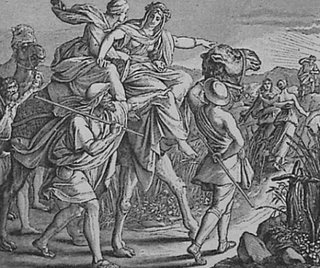 When Isaac was a young man, Abraham took him to Mount Moriah. There, Abraham, obeying God's command, prepared to sacrifice his son as a burnt offering. But God intervened, sparing Isaac's life and providing a ram as a substitute offering (22:1-14).
When Isaac was a young man, Abraham took him to Mount Moriah. There, Abraham, obeying God's command, prepared to sacrifice his son as a burnt offering. But God intervened, sparing Isaac's life and providing a ram as a substitute offering (22:1-14).In so doing, God also pointed to the substitutionary sacrifice of His own Son Jesus Christ for the sins of the world. When the author of Hebrews expounded on the faith of Abraham (11:8-19), he made special note of Abraham's belief that, in order to accomplish His purposes, "God was able even to raise [Isaac] from the dead, from which, figuratively speaking, he did receive him back. (v. 19)"
Abraham sent a faithful servant back among their kinfolk in order to find a bride for Isaac. There, the servant found Rebekah, who gladly traveled with this stranger to a new land, where she was given in marriage to Isaac (Genesis 24). They had twin sons, Esau and Jacob (25:19-26).
In his old age, Isaac became weak and blind. Before he died, he desired to give his blessing and the chief inheritance to Esau, his elder and favorite son, even though the Lord had promised Rebekah that their birth order would be reversed in the blessing and Jacob would be the favored son (25:23). However, Rebekah showed her favorite, Jacob, how to deceive his father and gain the blessing for himself (27:1-40). Of course, this resulted in years of bitter family strife, although Jacob and Esau later reconciled (Genesis 33).
Isaac lived to the age of 180 and was buried by his sons in the family burial cave of Machpelah (35:28-29).
Labels: abraham, biography, christianity, christology, commemoration, hagiography, isaac, israel, jacob, old testament, rebekah, sacrifice, sarah
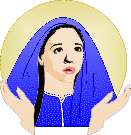 The honor paid to Saint Mary, the virgin mother of Jesus Christ our Lord, God, and Savior goes back to the earliest days of the Church. Indeed, it goes back farther: Even before the birth of her Son, Mary prophesied, "From now on all generations will call me blessed. (Luke 1:48 ESV)" Confessing her as "Mother of God" also confesses that the One whom she bore was and is, indeed, true God.
The honor paid to Saint Mary, the virgin mother of Jesus Christ our Lord, God, and Savior goes back to the earliest days of the Church. Indeed, it goes back farther: Even before the birth of her Son, Mary prophesied, "From now on all generations will call me blessed. (Luke 1:48 ESV)" Confessing her as "Mother of God" also confesses that the One whom she bore was and is, indeed, true God.The New Testament records several incidents from the life of the Virgin: her betrothal to Joseph, the Annunciation by the angel Gabriel that she was to bear the Messiah, her Visitation to Elizabeth the mother of John the Baptist, the Nativity of our Lord, the visits of the shepherds and the magi, her Purification and the Presentation of the infant Jesus in the Temple at the age of forty days, the flight into Egypt, the Passover visit to the Temple when Jesus was twelve, (Matthew 1:16, 18-25; Matthew 2; Luke 1:26-56; Luke 2); the wedding at Cana in Galilee and the performance of her Son's first miracle (at Mary's intercession, see John 2:1-11), the occasions when observers basically said of Jesus, "How can this man be special? We know his family!" (Matthew 13:54-56; Mark 6:1-3; Luke 4:22; see also John 6:42); an instance when she came with others to see Him while he was preaching (Matthew 12:46-50; Mark 3:31-35; Luke 8:19-21); and her presence at His crucifixion, where Jesus commended her to the care of His Beloved Disciple (John 19:25-27). Mary was also present with the apostles in Jerusalem following the Ascension, waiting for the promised Spirit (Acts 1:14). Thus, we see her present at many of the chief events of her Son's life.
Besides Jesus, only two people are mentioned by name in the Creeds. One is Pontius Pilate, Roman procurator of Judea from 26 to 36 AD. Knowing that Jesus was crucified by Pilate's order pins down the date of His death within a few years, certifying that we are not talking "once upon a time," like worshipers of some mythical god. His death is an historical event, something that really happened.
The other name in the Creeds is that of Mary. They say that Christ was "born of the virgin Mary." That is, they assert that he was truly and fully human, born of a woman and not descended from the skies like an angel. Jesus was not a spirit temporarily cloaked in a robe of human-seeming flesh.
Telling us that His mother was a virgin excludes the theory that Jesus was an ordinary man who was so virtuous that he eventually, at His baptism, became filled with a "Christ Spirit" by God. His virgin birth attests that He was always more than merely human, always one whose presence among us was in itself a miracle, from the first moment of His earthly existence. In Mary, Virgin and Mother, God gives us a sign that Jesus is both truly God and truly man. Emphasizing this point, the Council of Ephesis in AD 431 officially titled her Theotokos (God-bearer) and rejected and condemned the title Christotokos (Christ-bearer). Ask the Pastor comments on the distinction in Blessed Virgin Mary: Mother of God.
We know Little of Mary's life except as it intersects with the life of her Son; this is appropriate. The Scriptures record her words to the angel Gabriel, to her kinswoman Elizabeth, and to her Son on two occasions. The only recorded saying of hers to "ordinary" hearers is her instruction to the servants at the wedding feast: "Do whatever he [Jesus] tells you. (John 2:5 ESV)" Perhaps this should be the summation of her message to the world. To this day, she reminds us, "Listen to Jesus. Pay attention to my Son. Do as He says."
She didn't seek the regard of others on her own behalf. If our honor for the Blessed Virgin doesn't turn our attention from her to the One whom she bore and suckled, to the Word made flesh, then we may be certain that it is not the blessing that she seeks. A right regard for Mary always directs us to Him who made her womb His first earthly dwelling-place.
In different parts of the Church, the date is remembered in various ways. Roman Catholicism celebrates the Assumption of Mary and claims that she was taken, body and soul, to heaven. However, I've found contradictory teachings in the Roman Church, arguing whether she was translated in the manner of Enoch or Elijah, if she died and was resurrected on earth and then taken to heaven, or if her dead body was taken and then rejoined with her soul in heaven.
Meanwhile, Eastern Orthodoxy celebrates the Dormition of the Theotokos. It claims that Mary certainly died but that when Thomas visited three days later, her body was gone from the tomb. As to whether the body will be kept in heaven until the general resurrection on the Last Day or already rejoined with her spirit, Orthodoxy will not make a final dogmatic pronouncement.
In the rest of Christendom that follows a sanctorial calendar, the general belief seems to be that she likely died and awaits the resurrection with all others who departed in the Faith.
Lection
Psalm 45:10-17
Isaiah 61:7-11
Galatians 4:4-7
Luke 1:(39-45) 46-55
Collect of the Day
Almighty God, You chose the virgin Mary to be the mother of Your only Son. Grant that we, who are redeemed by His blood, may share with her in the glory of Your eternal kingdom; through Jesus Christ, Your Son, our Lord, who lives and reigns with You and the Holy Spirit, one God, now and forever.
or
Grant, we humbly pray, O Lord, to Your servants the gift of Your heavenly blessing that, as the Son of the Virgin Mary has granted us salvation, we may daily grow in Your favor; through Jesus Christ, Your Son, our Lord, who lives and reigns with You and the Holy Spirit, one God, now and forever.
Labels: acts, assumption, biography, christianity, creed, dormition, feasts, festivals, gospels, hagiography, jesus, mary, new testament, theotokos, virgin
 A river, a gulf, and a seaway are named in his honor. A number of Christian congregations and almost anyone known as "Larry" likewise owe their names to this martyr of the ancient Christian Church.
A river, a gulf, and a seaway are named in his honor. A number of Christian congregations and almost anyone known as "Larry" likewise owe their names to this martyr of the ancient Christian Church.Early in the third century A.D., Lawrence (Latin, Laurentius, also often known as "Lorenz," "Laurence," or "Lorenzo"), who was most likely born in Spain, made his way to Rome. There he was appointed chief of the seven deacons and was given the responsibility to manage church property and finances.
The emperor at the time, thinking that the church had valuable things worth confiscating, ordered Lorenz to produce the "treasures of the church." Saint Lorenz brought before the emperor the poor whose lives had been touched by Christian charity. He was then jailed and eventually executed in the year 258. Many accounts tell of his being roasted on a gridiron until dead. However, some scholars think that this tradition came about due to a faulty transcription and that the phrase assus est (he roasted) should have been rendered passus est (he suffered).
His martyrdom left a deep impression on the young church. Almost immediately, the date of His death, 10 August, became a permanent fixture on the commemorative calendar of the early Church.
Lection
Psalm 65:1-8 or 34:1-10
Deuteronomy 33:1-3 or Isaiah 26:1-4, 8-9, 12-13, 19-21
Revelation 7: 2-17 or 21:9-11, 22-27; 22:1-5
Matthew 5:1-12
Collect
Stir up, O merciful Father, Your people to true brotherly affection that we may gladly do good and serve our neighbor, as did Your servant Saint Lawrence, when he emptied the treasure of the Church to help the poor; through our Lord Jesus Christ, who lives and reigns with You and the Holy Spirit, one God, now and forever.
Labels: biography, christianity, church history, commemoration, feasts, hagiography, lawrence, lorenz, martyrdom, roman empire
 Lutheran pastor and theologian Hermann Otto Erich Sasse was born on 17 July 1895 at Sonnewalde, Lower Lusatia (Lausitz), Germany. He was the eldest of five children born to pharmacist Hermann Sasse and his wife Maria, née Berger. In 1913,he began reading theology and ancient philology at the University of Berlin. In later years, he claimed that his tutor in practical theology was war, as he was one of only six survivors from his battalion after engaging in trench warfare in Flanders.
Lutheran pastor and theologian Hermann Otto Erich Sasse was born on 17 July 1895 at Sonnewalde, Lower Lusatia (Lausitz), Germany. He was the eldest of five children born to pharmacist Hermann Sasse and his wife Maria, née Berger. In 1913,he began reading theology and ancient philology at the University of Berlin. In later years, he claimed that his tutor in practical theology was war, as he was one of only six survivors from his battalion after engaging in trench warfare in Flanders.After the war, he continued his studies and was ordained in 1920 in St Matthew's Church, Berlin. He served in several Brandenburg parishes took the licentiate in theology in Berlin in 1923. Sasse came to Hartford Seminary, Connecticut in 1926, where he earned a master's degree.
Hermann Sasse married Charlotte Margarete Naumann (d. 1964) on 11 September 1928 in St. Nicolai's Church, Oranienburg, Germany. Their union was blessed with three children.
During the tough economic times of the Great Depression, During the Depression, Sasse was made a Sozialpfarrer (pastor with social duties). As such, he reached out to those in need in the community, particularly to factory workers in Berlin.
Although remembered as one who resisted the watered-down theology of unionism, Sasse participated in the Ecumenical Movement and was a delegate and interpreter during the first world conference of the Faith and Order Movement in Lausanne, Switzerland (1927). He also attended the 1932 disarmament conference in Geneva.
Among German theologians, he ranks as one of the the earliest to speak out against Nazism. While criticizing some of its theology, he participated actively in the Confessing Church Movement that had emerged under Martin Niemöller and others. Sasse and Dietrich Bonhoeffer were among the small but growing church opposition to Hitler. In 1933, they were the primary authors of the Bethel Confession. This strongly trinitarian document also clearly condemned discrimination against the Jews. Rejecting an all-Aryan German Church, the Confession stated, "Instead of giving up, either willingly or unwillingly, in one area the ecclesial fraternity with the Jewish Christian that is created by word and sacrament, the Gentile Christians should rather expose themselves to persecution."
 Although he'd been working hand-in-hand with its members, Sasse left the synod that produced the Barmen Declaration. He objected to Karl Barth and others leading the Confessing Movement to wrongly arrogate church authority for itself. During this time, he continued as professor in church history at the University of Erlangen, Bavaria, a position he received in 1933. The German government withdrew his passport in 1935 but his popularity as a lecturer and protection from the dean of the faculty helped him to retain his university post through the Nazi era.
Although he'd been working hand-in-hand with its members, Sasse left the synod that produced the Barmen Declaration. He objected to Karl Barth and others leading the Confessing Movement to wrongly arrogate church authority for itself. During this time, he continued as professor in church history at the University of Erlangen, Bavaria, a position he received in 1933. The German government withdrew his passport in 1935 but his popularity as a lecturer and protection from the dean of the faculty helped him to retain his university post through the Nazi era.Uncomfortable with its theological compromises, Sasse protested at the 1948 formation of the Evangelical Church in Germany. His opposed its policy of restoration rather than renewal and expressed disquiet over state-supported university faculties of theology. This led him to join the Lutheran Free Church.
After receiving a call to teach at Immanuel Seminary (now Australian Lutheran College) in North Adelaide, South Australia, he migrated in 1949. There, he worked mightily to unite Australia's divided Lutheran churches, devoting much energy to this cause. Exercising his considerable teaching and writing skills, he helped to formulate and forge new doctrinal bases of agreement and was rewarded by seeing the 1966 church union.
Sasse stayed active in the German Lutheran communities of Adelaide and Melbourne. Through his many contacts, he assisted immigrants with pastoral advice and care.
Sasse also retained his global Lutheran connections — many in the United States knew him as "Mr. Lutheran." He maintained world-wide correspondence through regular doctrinal and pastoral "Letters to Lutheran Pastors." He continued to encourage ongoing theological research, particularly in the areas of Scripture as Word of God and the Eucharist. While maintaining his justly deserved reputation for strongly defending confessional and conservative positions, Sasse also kept active personal contacts across denominational boundaries.
 From its inception, Sasse involved himself in Australian Roman Catholic-Lutheran dialog. He finally retired from the seminary in 1969 but stayed active in the affairs of the Church. The Federal Republic of Germany honored him with the Order of Merit in 1972.
From its inception, Sasse involved himself in Australian Roman Catholic-Lutheran dialog. He finally retired from the seminary in 1969 but stayed active in the affairs of the Church. The Federal Republic of Germany honored him with the Order of Merit in 1972.Sasse saw over 450 of his works published. Included among them are Here We Stand (Minneapolis, 1946) and This is My Body (1959). A fire in his North Adelaide home claimed his life on 9 August 1976. Survived by two sons, he was buried in Centennial Park, Pasadena, South Australia. One obituary declared Sasse "Australia's most distinguished acquisition from the Continental theological scene."
Hermann Sasse was one of many who stood steadfast in confession of the Evangelical, Orthodox, Catholic, and Apostolic Faith. For a sampling of some of the others in Lutheranism, please see The Meanies of Grace. For more on and by Sasse, I recommend What Sasse Said and Hermann Sasse and the Liturgical Movement as possible starters. You can also find plenty of Sasse to read through this CPH search.
Suggested Lection
Psalm 46
Isaiah 55:6-11
Romans 10:5-17
John 15:1-11
Collect
O Lord God, heavenly Father, we pray that, as You raised up Hermann Sasse to resist the evils of Nazi philosophy and through him led Lutherans in Germany, Australia, and around the world into renewed appreciation of their confessional heritage and trust in the saving Gospel of Jesus Christ, so You would continue to provide Your Church with faithful pastors and leaders, keeping them steadfast in Your grace and truth, defending them against all enemies of Your Word, and bestowing on Christ's Church Militant Your saving peace; through Jesus Christ, Your Son, our Lord, who lives and reigns with You and the Holy Spirit, one God, now and forever.
Labels: australia, biography, christianity, church history, commemoration, confessionalism, ecumenical movement, german history, germany, hagiography, lutheranism, sasse, theology
 These "myrrh bearers" or "faithful women," as they're called among some Christians, with Mary Magdalene, are named in Scripture as the first visitors to the tomb of the crucified Christ early on the first day of the week. Their trek to His sepulcher was recorded in each of the Synoptic Gospels, although each includes different details. (see Matthew 28:1-8, Mark 16:1-8, and Luke 24:1-11).
These "myrrh bearers" or "faithful women," as they're called among some Christians, with Mary Magdalene, are named in Scripture as the first visitors to the tomb of the crucified Christ early on the first day of the week. Their trek to His sepulcher was recorded in each of the Synoptic Gospels, although each includes different details. (see Matthew 28:1-8, Mark 16:1-8, and Luke 24:1-11).Joanna was the wife of Chuza, a steward in Herod's household (Luke 8:3). Mary, the mother of James the son of Alphaeus, also faithfully provided care for Jesus and His disciples from the time of His Galilean ministry through His burial after the crucifixion. Salome, the mother of the sons of Zebedee (Matthew 27:56), joined with the women both at the cross and in the bringing of the spices to the garden tomb.
These "faithful women" have been honored in the Church throughout the centuries as examples of humble and devoted service to the Lord.
Suggested Lection
Psalm 45:1-9
1 Corinthians 15:1-11
Luke 23:54-24:11 or Mark 16:1-8
Suggested Collect
Blessed Lord, through Your only-begotten Son You overcame death and by Your Holy Spirit You call us to Him that we might believe and be saved. Grant that as the women came to His tomb on Easter morn and found joy where they expected sorrow, so we might also come to Christ Jesus, casting our cares upon Him and receiving forgiveness, peace, and the sure and certain hope of everlasting life through Him who reigns eternally with You and the Holy Spirit, one God, now and forever.
Labels: biography, commemoration, easter, gospels, hagiography, jesus, joanna, mary, mary magdalene, new testament, resurrection, salome
 Saint Joseph is mentioned in all four Gospels. He came from a small village called Arimathea in the hill country of Judea and was a respected member of the Sanhedrin, the Jewish ruling council in Jerusalem. Scholars presume that Joseph was a man of considerable means, since he owned his own unused tomb in a garden not far from the site of Jesus' crucifixion (Matthew 27:60).
Saint Joseph is mentioned in all four Gospels. He came from a small village called Arimathea in the hill country of Judea and was a respected member of the Sanhedrin, the Jewish ruling council in Jerusalem. Scholars presume that Joseph was a man of considerable means, since he owned his own unused tomb in a garden not far from the site of Jesus' crucifixion (Matthew 27:60).A man waiting expectantly for the kingdom of God, he went to Pontius Pilate after the death of Jesus and asked for Jesus' body (Mark 15:43). Along with Nicodemus, Joseph removed the body and placed it in the tomb (John 19:39). Their public devotion contrasted greatly to the fearfulness of the disciples who abandoned Jesus.
The perfume flask depicted here reminds us of Joseph's hurried work of preparing Christ's body for burial, which would have included rubbing the spices brought by Nicodemus on the body and the wrapping cloths.
Labels: biography, commemoration, crucifixion, good friday, gospels, hagiography, jesus, john, joseph of arimathea, luke, mark, matthew, new testament, nicodemus
 Remembered as a disciple of Martin Luther, Robert Barnes is considered to be among the first Lutheran martyrs. Born in 1495, he became the prior of the Augustinian monastery at Cambridge, England. Converted to Lutheran teaching, he shared his insights with many English scholars through writings and personal contacts.
Remembered as a disciple of Martin Luther, Robert Barnes is considered to be among the first Lutheran martyrs. Born in 1495, he became the prior of the Augustinian monastery at Cambridge, England. Converted to Lutheran teaching, he shared his insights with many English scholars through writings and personal contacts.During a time of exile to Germany he became a friend of Luther and later wrote a Latin summary of the main doctrines of the Augsburg Confession titled Sententiae.
Upon his return to England, Barnes shared his Lutheran doctrines and views in person with King Henry VIII and initially had a positive reception. In 1529 Barnes was named royal chaplain.
The changing political and ecclesiastical climate in England later claimed him as a victim; he was burned at the stake in Smithfield in 1540.
His final confession of faith was published by Luther, who called his friend Barnes "our good, pious table companion and guest of our home, this holy martyr, Saint Robertus."
For a bit more on Barnes, please read the introduction to Lutheran Carnival 26 at A Beggar at the Table.
Labels: biography, christianity, church history, commemoration, english history, hagiography, lutheranism, martin luther, martyrdom, reformation, robert barnes
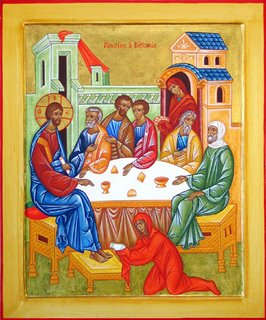 Mary, Martha, and Lazarus were disciples with whom Jesus had a special bond of love and friendship. The Gospel According to Saint John records that "Jesus loved Martha and her sister and Lazarus (11:5)."
Mary, Martha, and Lazarus were disciples with whom Jesus had a special bond of love and friendship. The Gospel According to Saint John records that "Jesus loved Martha and her sister and Lazarus (11:5)."On one occasion, Martha welcomed Jesus into their home for a meal. While she did all the work, Mary sat at Jesus' feet listening to his Word and was commended by Jesus for choosing the "good portion, which will not be taken away from her (Luke 10:38-42)."
When their brother Lazarus died, Jesus spoke to Martha this beautiful Gospel promise: "I am the Resurrection and the Life. Whoever believes in me, though he die, yet shall he live." We note that in this instance, it was Martha who made the wonderful confessions of faith in Christ (John 11:1-44).
Ironically, raising Lazarus from the dead made Jesus' enemies among the Jewish leaders more determined than ever to kill Him (11:45-57).
Six days before Jesus was crucified, Mary anointed His feet with a very expensive fragrant oil and wiped them with her hair, not knowing at the time that she was doing it in preparation for her Lord's burial (John 12:1-8).
Labels: bethany, biography, commemoration, gospels, hagiography, jesus, john, lazarus, luke, martha, mary, new testament, resurrection
 Johann Sebastian Bach (1685-1750) is acknowledged as one of the most famous and gifted of all composers past and present in the entire western world. Orphaned at the age of ten, Bach studied with various family members but was mostly self-taught in music.
Johann Sebastian Bach (1685-1750) is acknowledged as one of the most famous and gifted of all composers past and present in the entire western world. Orphaned at the age of ten, Bach studied with various family members but was mostly self-taught in music.He began his professional career as conductor, performer, composer, teacher, and organ consultant at age 19 in the town of Arnstadt. He traveled wherever he received good commissions and steady employment, ending up in Leipzig, where the last 27 years of his life found him responsible for all the music in the city's four Lutheran churches.
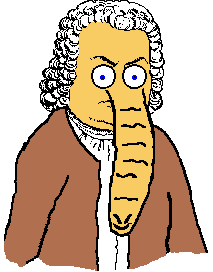 Acclaimed more in his own time as a superb keyboard artist, the majority of his compositions fell into disuse following his death, which musicologists use to date the end of the Baroque Period and the beginning of the Classical Era. However, his compositional ability was rediscovered, in large part due to the efforts of Felix Mendelssohn.
Acclaimed more in his own time as a superb keyboard artist, the majority of his compositions fell into disuse following his death, which musicologists use to date the end of the Baroque Period and the beginning of the Classical Era. However, his compositional ability was rediscovered, in large part due to the efforts of Felix Mendelssohn.The genius and sheer magnitude of Bach's vocal and instrumental compositions remain overwhelming. Also, whether due to nature or nurture, he was but one of the giants in, perhaps, the most talented musical family of all time.
Christendom especially honors J. S. Bach, a staunch and devoted Lutheran, for his lifelong insistence that his music was written primarily for the liturgical life of the Church, glorifying God and edifying His people. For an overview of the Christological basis of his work and a strong argument that he was among the theological giants of Lutheranism, please read J. S. Bach: Orthodox Lutheran Theologian?.
Today we remember his "heavenly birthday," for it was on 28 July AD 1750 that the Lord translated Mr. Bach to glory.
Soli deo gloria — To God alone the glory! These words appear on most manuscripts of Bach's compositions as testimony to his faith and his idea of music's highest, noblest use.
Labels: bach, biography, christianity, church history, commemorations, german history, hagiography, liturgics, lutheranism, music
 Ólafr Haraldsson (also known as Olav, Olafe, Oláfr hinn helgi, and Olavus rex) was born in 995 to Harald Grenske and Åsta Gudbrandsdatter. While Snoore says that he was baptized in 998 in Norway, it's more likely that it was by the hand of Archbishop Robert in Rouen, France around 1010. As was common among young Norsemen, he spent much of his youth going a-viking (raiding), first in the Baltic, then Denmark, and finally in the British Isles. He was nicknamed "Digre" (physically large) and some believed him to be a reincarnation of a previous (pagan) Viking king Olav Digre. While involved in numerous armed conflicts, Olaf also developed a deep interest in Christianity.
Ólafr Haraldsson (also known as Olav, Olafe, Oláfr hinn helgi, and Olavus rex) was born in 995 to Harald Grenske and Åsta Gudbrandsdatter. While Snoore says that he was baptized in 998 in Norway, it's more likely that it was by the hand of Archbishop Robert in Rouen, France around 1010. As was common among young Norsemen, he spent much of his youth going a-viking (raiding), first in the Baltic, then Denmark, and finally in the British Isles. He was nicknamed "Digre" (physically large) and some believed him to be a reincarnation of a previous (pagan) Viking king Olav Digre. While involved in numerous armed conflicts, Olaf also developed a deep interest in Christianity.Olaf declared himself King of Norway in 1015. Following battles with various petty kings, he ruled until 1029, although his strength was greatly reduced following his loss in the Battle of the Helgeå (1026). As monarch, he struggled to root out heathenism and make Christianity the religion of the realm. Like his ancestor Olaf Trygvesson, he frequently attacked the old faith and customs. Olaf destroyed pagan temples and built Christian churches in their place. He brought many bishops and priests from England, a practice later followed by King Saint Canute of Denmark. It appears that he based ecclesiastical organization on the Anglo-Saxon model.
The rebellion against Olaf stemmed but in part from his unflinching Christianity. Many of the nobles were also exasperated by his ongoing struggle with the old Norse method of governance and his never-ending desire for a truly united Norway. The governing clans enlisted King Canute of Denmark and England for help in ousting Olaf. Once he was banished, the clans elected Canute as King of Norway. Therefore, he became not only an icon of the Christian Faith but also one of Norwegian nationalism — an image he carries even among secular Norwegians to this day.
 After Canute's vassal Håkon Eiriksson died, Olaf returned from his two year exile and met the rebellious clans at Stiklestad on 29 July 1030. Although neither King Canute or the Danes took part, Olaf — who fought courageously — was mortally wounded at that battle and died in the battlefield. His final recorded words were the prayer, "God help me."
After Canute's vassal Håkon Eiriksson died, Olaf returned from his two year exile and met the rebellious clans at Stiklestad on 29 July 1030. Although neither King Canute or the Danes took part, Olaf — who fought courageously — was mortally wounded at that battle and died in the battlefield. His final recorded words were the prayer, "God help me."He was disinterred a year after his death and his remains moved to the Church of St. Clement in Nidaros (current Trondhjem). There, Bishop Grimkel and Earl Einar Tambeskjelver placed his corpse in a coffin and laid it on the church's high altar. At that time, the bishop also declared Olaf a saint. Although Olaf was embraced by most Norwegian Lutherans, his remains disappeared as part of the iconoclasm that occasionally accompanied the Reformation.
His cult spread widely in the Middle Ages, moving from Norway to Denmark, Sweden, and even parts of England. Although a rather harsh ruler and prone to rough treatment of his enemies, Olaf became Norway's patron saint. The cult of Olaf not only unified the country, it also fulfilled the conversion of the people, something for which the king had fought so hard. While divisive in life, Olaf in death held a unifying power that defied outside state and religious rulers attempts to undo his dream.
Although Olav was certainly not the first to introduce Christianity to Norway, he first codified the faith in 1024, laying the basis for the Church of Norway. So high did Olaf's legal arrangements for the Church of Norway come to stand in the eyes of the Norwegian people and clergy, that when Pope Gregory VII attempted to make clerical celibacy binding on the priests of Western Europe in 1074-75, the Norwegians largely ignored him, since celibacy wasn't mentioned in Olaf's legal code for their church. Although he continued to be known through most of his life as Olaf digre, in death he remains best known by as Olav den hellige (Olaf the Holy).
The coat of arms of Norway is a lion holding the battle axe of St. Olaf in his forepaws.
Suggested Lection
Wisdom 10:10-14
Psalm 31:1-7
James 1:2-4, 12
Matthew 16:24-28
Collect
Almighty, eternal God, you are the crown of kings and the triumph of martyrs. We thank You for the bold confession made by Your blessed martyr, Olav We praise your greatness in his death and we pray You give us the crown of life that You have promised those who believe in Your Son Jesus Christ, who lives and reigns with you and the Holy Spirit, one God, forever and ever.
See Wikipedia, the Catholic Encyclopedia, and the Christian Cyclopedia for more.
Labels: biography, christianity, church history, commemoration, hagiography, iconoclasm, lutheranism, martyrdom, norway, olaf, scandanavia
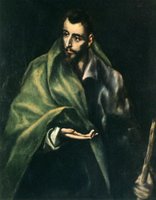 James, son of Zebedee, and his brother John were among Our Lord's twelve disciples. Together with Peter, these two were privileged to behold the Transfiguration (Matthew 17:1; Mark 9:2; Luke 9:28). They witnessed the healing of Peter's mother-in-law (Mark 1:29-31) and the raising of the daughter of Jairus (Mark 5:37; Luke 8:51). Jesus called them aside to watch and pray with Him in the garden of Gethsemane on the night before His death (Matthew 26:37; Mark 14:33).
James, son of Zebedee, and his brother John were among Our Lord's twelve disciples. Together with Peter, these two were privileged to behold the Transfiguration (Matthew 17:1; Mark 9:2; Luke 9:28). They witnessed the healing of Peter's mother-in-law (Mark 1:29-31) and the raising of the daughter of Jairus (Mark 5:37; Luke 8:51). Jesus called them aside to watch and pray with Him in the garden of Gethsemane on the night before His death (Matthew 26:37; Mark 14:33).James and John may have been from a higher social level than the average fisherman. Their father could afford hired servants (Mark 1:20), and John (assuming him to be identical with the "beloved disciple") had connections with the high priest (John 18:15).
Jesus nicknamed the brothers Boanerges — Sons of Thunder — (Mark 3:17), probably commenting upon their headstrong, hot-tempered, and impulsive natures. So they seem to be in two incidents reported in the Gospels. Once, Jesus and the disciples were refused the hospitality of a Samaritan village, and James and John proposed to call down fire from heaven on the offenders (Luke 9:51-56). On another occasion, they asked Jesus for a special place of honor in the Kingdom, and were told that the place of honor is the place of suffering (Matthew 20:20-23; Mark 10:35-41).
 In about AD 42, shortly before Passover (Acts 12:1-2), James was beheaded by order of Herod Agrippa I, grandson of Herod the Great (who tried to kill the infant Jesus; see Matthew 2), nephew of Herod Antipas (who killed John the Baptist — Mark 6:14-29 — and examined Jesus on Good Friday — Luke 23:6-16), and father of Herod Agrippa II (who heard the defense of Paul before Festus — Acts 25:13-26:32). James was first among the Twelve to suffer martyrdom, and the only one whose death is recorded in the New Testament.
In about AD 42, shortly before Passover (Acts 12:1-2), James was beheaded by order of Herod Agrippa I, grandson of Herod the Great (who tried to kill the infant Jesus; see Matthew 2), nephew of Herod Antipas (who killed John the Baptist — Mark 6:14-29 — and examined Jesus on Good Friday — Luke 23:6-16), and father of Herod Agrippa II (who heard the defense of Paul before Festus — Acts 25:13-26:32). James was first among the Twelve to suffer martyrdom, and the only one whose death is recorded in the New Testament.James is often called "James Major" (also "the Greater" or "the Elder") to distinguish him from other New Testament people named James. Tradition has it that he made a missionary journey to Spain, and that after his death his body was taken to Spain and buried there at Compostela. His supposed burial place there was a major site of pilgrimage in the Middle Ages, and the Spaniards fighting to drive their Moorish conquerors out of Spain took "Santiago de Compostela!" (Saint James of Compostela) as one of their chief war-cries. (The Spanish form of "James" is Diego or Iago. In most languages, "James" and "Jacob" are identical. Where an English Bible has "James," a Greek Bible has Iakobos.
The sword (the instrument of his death) and the scallop shell are both traditional representations of the apostle.
Lection
Psalm 56
Acts 11:27-12:5
Romans 8:28-39
Mark 10:35-45
Collect
Grant, O Lord, that as Saint James the apostle readily followed the calling of Your Son Jesus Christ, we may by Your grace be enabled to forsake all false and passing allurements and follow Him alone; through Jesus Christ, our Lord, who lives and reigns with You and the Holy Spirit, one God, now and forever.
Labels: apostle, bible, biography, disciple, feasts, festivals, gospels, hagiography, jacob, james, jesus, john, martyrdom, new testament, zebedee
 The Gospels mention Mary of Magdala as one of the women of Galilee who followed Jesus and His disciples. She witnessed His crucifixion and burial, and went to the tomb on Easter Sunday to anoint His body. She was the first recorded witness of the risen Christ and was sent by Him to tell the disciples. Thus, early Christian writings sometimes refer to her as "the apostle to the apostles" (apostle means "one who is sent").
The Gospels mention Mary of Magdala as one of the women of Galilee who followed Jesus and His disciples. She witnessed His crucifixion and burial, and went to the tomb on Easter Sunday to anoint His body. She was the first recorded witness of the risen Christ and was sent by Him to tell the disciples. Thus, early Christian writings sometimes refer to her as "the apostle to the apostles" (apostle means "one who is sent").Confusion sometimes abounds as to whether she is the same person as Mary of Bethany (sister of Martha and Lazarus) or the unnamed woman who anointed Jesus's feet (Luke 7:36-48). Add in the statement that Jesus cast seven demons out of her (Luke 8:2) and you get the origins of a tradition that she was a prostitute before she met Jesus.
Following the assumption (possibly quite misguided) that Mary Magdalene truly had been a spectacular sinner whose penitential sorrow was deep and complete — and possibly because John described her as crying at the tomb of Jesus — artists often portray her either as weeping or with red eyes from having wept. This appearance (and a slight corruption in translation) led to the English word "maudlin," meaning "effusively or tearfully sentimental." Magdalen College at Oxford and Magdalene College at Cambridge (note the different spellings) — both pronounced "Maudlin" — derive their names from this Saint Mary.
Since the printing of Dan Brown's book The Da Vinci Code and the subsequent motion picture, ancient, heretical ideas about marriage or a less permanent sexual relationship between Mary and Jesus have gained ground. Some even twist an offhand statement from Martin Luther to buttress this argument. Contrary to these false teachings, please read Was Jesus Married and Luther, Jesus, and Mary Magdalene.
Lection
Psalm 73:23-28
Proverbs 31:10-31
Acts 13:26-31
John 20:1-2, 11-18
Collect
Almighty God, Your Son, Jesus Christ, restored Mary Magdalene to health and called her to be the first witness of His resurrection. Heal us from all our infirmities, and call us to know You in the power of Your Son’s unending life; through the same Jesus Christ, our Lord, who lives and reigns with You and the Holy Spirit, one God, now and forever.
Labels: apostle, bible, biography, christianity, easter, feasts, festivals, gospels, hagiography, jesus, mary, mary magdalene, new testament, resurrection
 Ezekiel, the son of Buzi, was a priest, called by God to be a prophet to the exiles during the Babylonian captivity (Ezekiel 1:3). In 597 B.C. King Nebuchadnezzar and the Babylonian army brought the king of Judah and thousands of the best citizens of Jerusalem — including Ezekiel — to Babylon (2 Kings 24:8-16).
Ezekiel, the son of Buzi, was a priest, called by God to be a prophet to the exiles during the Babylonian captivity (Ezekiel 1:3). In 597 B.C. King Nebuchadnezzar and the Babylonian army brought the king of Judah and thousands of the best citizens of Jerusalem — including Ezekiel — to Babylon (2 Kings 24:8-16).Ezekiel's priestly background profoundly stamped his prophecy, as the holiness of God and the Temple figure prominently in his messages (for example, Ezekiel 9-10 and 40-48). From 593 B.C. to the destruction of Jerusalem and the temple in 586 B.C., Ezekiel prophesied the inevitability of divine judgment on Jerusalem, on the exiles in Babylon, and on seven nations that surrounded Israel (Ezekiel 1–32). Jerusalem would certainly fall and the exiles would not quickly return — the just consequences of their sins.
Especially in the early part of the book, much of what the Lord "said" to His people was delivered in the form of action prophecies. In these, Ezekiel acted out representations of coming events pertaining to the fall of Judah, the destruction of the temple, and the seeming end of the Davidic line of kings. These action prophecies included the eating of the scroll (3:1-2), being struck with dumbness (3:22-27), sketching of the city of Jerusalem (4:1-3), lying on one side and then the other (4:4-8), eating restricted rations cooked on a fire of dried dung (4:9-17), and shaving his hair and beard with a sword before dividing the hair (5:1-4). Some seem a bit strange at first glance, once we understand their meaning and context, their messages are quite easily comprehended.
Once word reached Ezekiel that Jerusalem and the temple were destroyed, his message became one of comfort and hope. Through him God promised that his people would experience future restoration, renewal, and revival in the coming Messianic kingdom (Ezekiel 33-48).
Much of the strange symbolism of Ezekiel's prophecies was later employed in the Revelation to Saint John. Among these are the visions of the four living creatures as seen in Ezekiel 1 and Revelation 4.
See Happenings for a hymn stanza written for the Commemoration of Ezekiel.
Labels: babylonian captivity, bible, biography, christianity, christology, commemorations, ezekiel, hagiography, israel, old testament, prophet, revelation
 The prophet Elijah, whose name means, "My God is Yahweh [the Lord]," prophesied in the northern kingdom of Israel, mostly during the reign of Ahab (874 – 853 B.C.).
The prophet Elijah, whose name means, "My God is Yahweh [the Lord]," prophesied in the northern kingdom of Israel, mostly during the reign of Ahab (874 – 853 B.C.).Ahab, under the influence of his pagan wife Jezebel, had encouraged the worship of Baal throughout his kingdom, even as Jezebel sought to get rid of the worship of Yahweh. Elijah was called by God to denounce this idolatry and to call the people of Israel back to the worship Yahweh as the only true God (as he did in 1 Kings 18:20-40).
Elijah was a rugged and imposing figure, living in the wilderness and dressing in a garment of camel's hair and a leather belt (2 Kings 1:8). He was a prophet mighty in word and deed. The Lord worked many miracles through Elijah, including the raising of the dead (1 Kings 17:17-24) and the effecting of a long drought in Israel (1 Kings 17:1).
At the end of his ministry, he was taken up into heaven as Elisha, his successor, looked on (2 Kings 2:11). Later on, the Lord proclaimed through the prophet Malachi that Elijah would return before the coming of the Messiah (Malachi 4:5-6), a prophecy that was fulfilled in the prophetic ministry of John the Baptist (see Jesus' words in Matthew 11:1-19).
See Happenings for a hymn stanza written for the Commemoration of Elijah.
Labels: 1 kings, 2 kings, ahab, biography, commemorations, elijah, elisha, hagiography, israel, jezebel, john the baptist, old testament, prophet, transfiguration
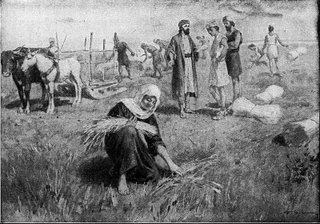 Ruth, the subject of the book bearing her name, is an inspiring example of God's grace. Although she was a Gentile, God made her the great-grandmother of King David (Ruth 4:17), and an ancestress of Jesus Himself (Matthew 1:1-17).
Ruth, the subject of the book bearing her name, is an inspiring example of God's grace. Although she was a Gentile, God made her the great-grandmother of King David (Ruth 4:17), and an ancestress of Jesus Himself (Matthew 1:1-17).A famine in Israel led Elimelech and Naomi of Bethlehem to emigrate to the neighboring nation of Moab with their two sons. The sons married Moabite women, Orpah and Ruth, but after about ten years, Elimelech and his sons died (Ruth 1:1-5).
Naomi then decided to return to Bethlehem and urged her daughters-in-law to return to their families. Orpah listened to Naomi's plea, but Ruth refused, replying with the stirring words: "Where you go I will go, and where you lodge I will lodge. Your people shall be my people, and your God my God. (1:16)"
After Ruth arrived in Bethlehem, Boaz, a close relative of Elimelech, agreed to be Ruth's "redeemer" (3:7-13; 4:9-12). He took her as his wife, and Ruth gave birth to Obed, the grandfather of David (4:13-17), thus preserving the Messianic seed. See Boaz, Ruth, and the Genealogy of Jesus at Ask the Pastor for a deeper theological examination of the account of Ruth and Boaz, including its Christological connection.
Ruth's kindness and selfless loyalty toward Naomi — and her faith in Naomi's God — have long endeared her to the faithful and redounded to God's praise for His merciful choice of one so unexpected.
Labels: biography, boaz, christianity, christology, commemorations, david, feasts, festivals, genealogy, gospels, hagiography, jesus, matthew, naomi, old testament, ruth
Bo Harald Giertz was born 31 August 1905 in Räpplinge, Borgholm, Öland (Kalmar), Sweden. He came from a prominent family and his father was a noted surgeon and head of one of Sweden's largest hospitals He was also an atheist. Bo planned to follow in his father's path and in 1924 he enrolled in the School of Medicine at the University of Uppsala. While there, however, theological students began challenging his belief system and, by the guidance of the Holy Spirit, he came to faith in Jesus Christ, left the school of medicine, and entered the University School of Theology.
In 1934, Giertz was ordained in the Linkoping Cathedral. He became assistant to the bishop and was given responsibility for working with the youth. His own faith and his conviction concerning the relevance of Christianity were on display for the thousands of young people who came under his care. Even as orthodox Lutherans lauded him, he also drew attacks from modernists in the Swedish state church and secularists as his writings spread in newspapers and periodicals. The public knew him as a talented and faithful confessor of a Church doctrine that was based in Scripture, confessed in the Creeds, and expounded in the Lutheran Confessions.
Giertz became a priest in Torpa in 1938, serving that parish until 1949, when he was consecrated as Bishop of Gothenburg. While serving Torpa, he wrote With My Own Eyes, a retelling of the Gospels (1947), four theological works, Christ's Church (1939), Church Piety (1939), The Great Lie and the Great Truth (1945), and The Battle for Man (1946), the catechetical book The Foundation (1942), and two novels The Hammer of God (1941) and Faith Alone (1943). These latter, particularly Hammer of God, became popular throughout Scandinavia and then around the globe.
The attention to theology and care for souls that Giertz evidenced in Torpa continued when he became Bishop of Gothenburg in 1949. As the youngest man elected and consecrated to serve the Church of Sweden as a diocesan bishop, he combined a somewhat pietistic type of pastoral care with High Church Lutheran theology, traits that are noticeable in his novels. Following the decisions of the Swedish Parliament and the Church Assembly to ordain women in the Church of Sweden (1958), Giertz became a leader of the opposition. In that same year, he invited all confessional groups in the Church of Sweden to form The Church Movement for Bible and Confession in response to the Assembly's decision.
The demands of the bishopric and the challenges of women's ordination and modernist theology slowed his writing for a time but once he became Bishop Emeritus, Giertz returned to the printed word in full force. He wrote The ABCs of Our Christian Faith in 1971, following it with The Knights of Rhodes (1972), another best-selling novel, the devotional books To Believe in Christ (1973) and To Live with Christ (1974), a new translation of the New Testament with Commentary (1977-1982), and, as a nonagenarian, he wrote The Living God — A Guide to the Christian Faith (1995). Most of Giertz's writings are not now available in English but new translations have begun to appear as the desire to read him grows.
Giertz pioneered a return to every Sunday celebration of the Lord's Supper, something that had largely vanished in the Church of Sweden due to the erosion caused by Pietism and Rationalism. He strongly urged pastors to pray the Daily Offices, something he applied in his own devotional life. Although often rejected by the leaders of the Church of Sweden, Giertz remains popular with true Lutherans in his own country, throughout Scandinavia, and across the world. Of him, the Reverend Hans O. Andrae wrote, "In his vision of the One Holy Christian and Apostolic Church, Giertz integrated a vibrant Evangelical-Lutheran orthodoxy, the Church's traditional liturgy, and sincere church piety into a harmonious and powerful wholeness."
Suggested Lection
Psalm 46
Isaiah 55:6-11
Romans 10:5-17
John 15:1-11
Collect
O Lord God, heavenly Father, we pray that, as You raised up Bo Harald Giertz to lead Swedish Lutherans into a renewed appreciation of their confessional heritage and trust in the saving Gospel of Jesus Christ, and as You spoke to the entire Church through his writings, so You would continue to provide faithful pastors and leaders, keep us steadfast in Your grace and truth, defend us against all enemies of Your Word, and bestow on Christ's Church Militant Your saving peace; through Jesus Christ, Your Son, our Lord, who lives and reigns with You and the Holy Spirit, one God, now and forever.
Labels: biography, bo giertz, christianity, church history, commemorations, european history, hagiography, lutheranism, sweden

